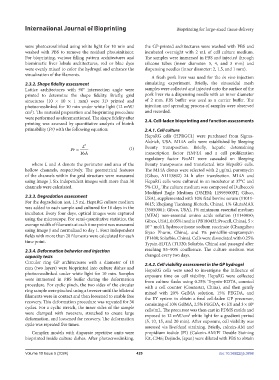Page 437 - IJB-10-5
P. 437
International Journal of Bioprinting Bioprinting for large-sized tissue delivery
were photocrosslinked using white light for 10 min and the GP-printed architectures were washed with PBS and
washed with PBS to remove the residual photoinitiator. incubated overnight with 2 mL of cell culture medium.
For bioprinting, various filling pattern architectures and The samples were immersed in PBS and injected through
biomimetic liver lobule architectures, red or blue dyes silicone tubes (inner diameter: 5, 4, and 3 mm) and
were evenly mixed to color the hydrogel and enhance the dispensing needles (inner diameter: 2, 1.5, and 1 mm).
visualization of the filaments.
A fresh pork liver was used for the in vivo injection
2.3.2. Shape fidelity assessment simulating experiment. Briefly, the sinusoidal mesh
Lattice architectures with 90° intersection angle were samples were collected and injected onto the surface of the
printed to determine the shape fidelity. Briefly, grid pork liver via a dispensing needle with an inner diameter
structures (10 × 10 × 1 mm) were 3D printed and of 2 mm. PBS buffer was used as a carrier buffer. The
photocrosslinked for 10 min under white light (12 mW/ injection and spreading process of samples were observed
cm ). The material preparation and bioprinting procedure and recorded.
2
were performed as aforementioned. The shape fidelity after 2.4. Cell-laden bioprinting and function assessments
printing was assessed by quantitative analysis of bioink
printability (Pr) with the following equation: 2.4.1. Cell culture
HepaRG cells (HPRGC1) were purchased from Sigma-
Aldrich, USA. M14A cells were established by Sleeping
L 2 (I) Beauty transposition. Briefly, hepatic determining
Pr = 16 A transcription factor HNF4A and a cell proliferation
regulatory factor FoxM1 were cascaded on Sleeping
where L and A denote the perimeter and area of the Beauty transposons and transfected into HepaRG cells.
hollow channels, respectively. The geometrical features The M14A clones were selected with 2 μg/mL puromycin
of the channels within the grid structure were measured (Gibco, A1113802) 24 h after transfection. M14A and
using Image J. Six independent images with more than 30 HepaRG cells were cultured in an incubator at 37°C and
channels were calculated. 5% CO . The culture medium was composed of Dulbecco’s
2
Modified Eagle Medium (DMEM; 11995500BT; Gibco,
2.3.3. Degradation assessment USA), supplemented with 10% fetal bovine serum (11011-
For the degradation test, 1.5 mL HepaRG culture medium 8615; Zhejiang Tianhang Biotech, China), 1% GlutaMAX
was added to each sample and cultured for 16 days in the (35050061; Gibco, USA), 1% minimum essential medium
incubator. Every four days, optical images were captured (MEM) non-essential amino acids solution (11140050;
using the microscope. For semi-quantitative statistics, the Gibco, USA), 0.05% insulin (PB180432; Procell, China), 5 ×
average width of filaments at each time point was measured 10 mol/L hydrocortisone sodium succinate (Changzhou
−5
using Image J and normalized to day 1. Four independent Siyao Pharm, China), and 1% penicillin-streptomycin
fields with more than 20 filaments were calculated for each (P1400; Solarbio, China). Cells were dissociated with 0.25%
time point. Typsin-EDTA (T1320; Solarbio, China) and passaged after
2.3.4. Deformation behavior and injection reaching 85–90% confluence. The culture medium was
capacity tests changed every two days.
Circular ring GP architectures with a diameter of 10 2.4.2. Cell viability assessment in the GP hydrogel
mm (two layers) were bioprinted into culture dishes and HepaRG cells were used to investigate the influence of
photocrosslinked under white light for 10 min. Samples exposure time on cell viability. HepaRG were collected
were immersed in PBS buffer during the deformation from culture flasks using 0.25% Trypsin-EDTA, counted
procedure. For cyclic pinch, the two sides of the circular with a cell counter (Countstar, China), and then gently
ring sample were pinched using a tweezer until the bilateral mixed with 20% GelMA solution, 15% PEGDA, and
filaments were in contact and then loosened to enable free the EY system to obtain a final cell-laden GP precursor,
recovery. This deformation procedure was repeated for 30 consisting of 10% GelMA, 2.5% PEGDA, 4× EY and 3 × 10
6
cycles. For a cyclic stretch, the inner sides of the sample cells/mL. The precursor was then cast in PDMS molds and
were clamped with tweezers, stretched to create large exposed to 12 mW/cm white light for a gradient period
2
deformation, and loosened for recovery. The deformation (5, 10, 15, and 20 min). After exposure, cell viability was
cycle was repeated five times. assessed via live/dead straining. Briefly, calcein-AM and
Complex models with disparate repetitive units were propidium iodide (PI) (Calcein-AM/PI Double Staining
bioprinted inside culture dishes. After photocrosslinking, Kit, C346; Dojindo, Japan) were diluted with PBS to obtain
Volume 10 Issue 5 (2024) 429 doi: 10.36922/ijb.3898

